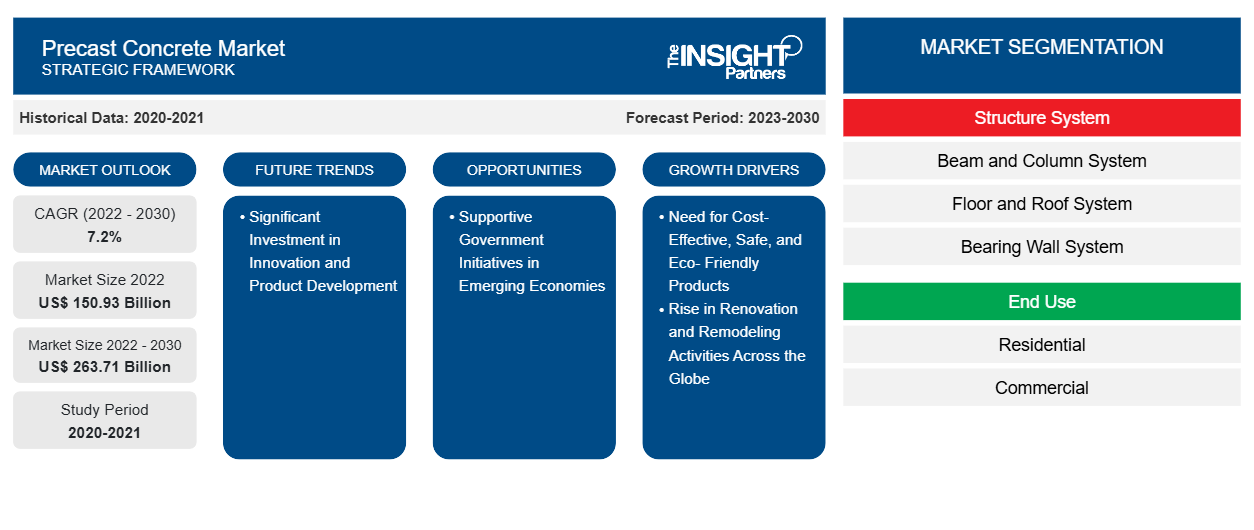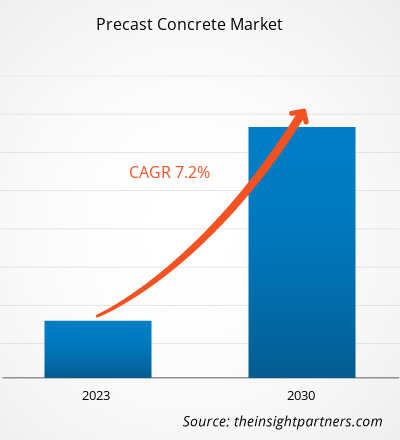[Research Report] The precast concrete market size was valued at US$ 150.93 billion in 2022 and is projected to reach US$ 263.71 billion by 2030; it is expected to record a CAGR of 7.2% from 2022 to 2030.
MARKET ANALYSIS
Precast concrete is a construction material manufactured by casting concrete in a reusable or moldable framework, which is then cured in controlled environment. Such materials are precasted and prefabricated at the time of manufacturing and are later assembled and molded at the construction site. Such structures have the ability to enhance construction speed and improve productivity and quality while being cost-effective. Thus, with the growing demand for cost-effective and safe material, the demand for precast concrete is expected to rise. Such form of structures are categorized as sustainable building materials as they can significantly be reused or remolded, thereby reducing their impact on environment. The growing adoption of green and modular construction material is expected to proliferate the demand for precast concrete products in the global market.
GROWTH DRIVERS AND CHALLENGES
Precast technology is often correlated with performance, protection, and durability, all of which are good advantages over traditional building methods. Apart from these advantages, one of the essential feature of precast is its potential to reduce construction costs and provide substantial savings before, during, and after the project. Unlike other materials used in conventional building components, precast components are usually made from locally available natural raw materials such as cement, stones, sand, and gravel. It can be reused or recycled completely, which helps in reducing the environmental impact of raw materials over their life cycle. In addition, there is prime focus on promoting safe and digitized construction that could lessen the amount of fatalities at the site. For instance, several reported incidents suggest the fatalities caused while lifting hollow-core slabs with clamps. The use of precast components in the construction work can ensure the safety and protection at construction sites.
Precast concrete is also a popular building material for office buildings. The building walls can be fabricated while the on-site foundations are being built, thereby saving time and ensuring early occupancy. Due to the speed and ease with which precast structures can be constructed, precast has gained immense popularity to be preferred as a building material in parking structures. Precast concrete allows for safe, cost-effective construction in all weather conditions. It also provides long clear spans and open spaces needed in parking structures. In addition, precast concrete saves time and money, and it has greater quality control than on-site concrete construction. Precast concrete construction has many benefits such as ecofriendly, earthquake resistance, and energy-efficient over cast-in-situ concrete structures, as well as steel, timber, and masonry structures. It allows for a faster and more reliable construction process. The rising focus toward cost-effective, safe, and environment-friendly products is expected to stimulate the growth of the global precast concrete market.
Customize This Report To Suit Your Requirement
You will get customization on any report - free of charge - including parts of this report, or country-level analysis, Excel Data pack, as well as avail great offers and discounts for start-ups & universities
Precast Concrete Market: Strategic Insights

-
Get Top Key Market Trends of this report.This FREE sample will include data analysis, ranging from market trends to estimates and forecasts.
REPORT SEGMENTATION AND SCOPE
The "Global Precast Concrete Market Forecast to 2030" is a specialized and in-depth study with a major focus on the global precast concrete market trends and opportunities. The report aims to provide an overview of the market with detailed market segmentation based on structure system, end use, and geography. The global precast concrete market has been witnessing high growth over the recent past and is expected to continue this trend during the forecast period. The report provides key statistics on the use of precast concrete worldwide along with their demand in major regions and countries. In addition, it provides a qualitative assessment of various factors affecting the precast concrete market performance in major regions and countries. The report also includes a comprehensive analysis of the leading market players and their key strategic developments. Several analyses on the market dynamics are also included to help identify the key driving factors, market trends, and lucrative precast concrete market opportunities that would, in turn, aid in identifying the major revenue pockets.
Further, ecosystem analysis and Porter’s five forces analysis provide a 360-degree view of the global precast concrete market, which helps understand the entire supply chain and various factors affecting the market growth.
SEGMENTAL ANALYSIS
The global precast concrete market is categorized on the basis of structure system and end use. In terms of structure system, the market is segmented into beam and column system, floor and roof system, bearing wall system, façade system, and others. By end use, the market is segregated into residential, commercial, and others.
Based on structure system, the beam and column system segment held a significant global precast concrete market share in 2022. Beams are the structural components that are formed in one of three fundamental shapes, including rectangular, inverted tee beams, and L-beams. Beams are primarily utilized to support deck members such as solid slabs, double tees, hollow-core, and sometimes other beams. By end use, the commercial segment led the global precast concrete market with the largest market share in 2022. The commercial sector includes sports facilities, schools, colleges, government institutions, hospitals, schools, offices, and other commercial spaces. Precast concrete is used for the construction of sports facilities worldwide. Precast sport specialized components allow general contractors and architects the flexibility to achieve innovative and complex designs with maximized seating.
REGIONAL ANALYSIS
The report provides a detailed overview of the global precast concrete market with respect to five major regions—North America, Europe, Asia Pacific (APAC), Middle East and Africa (MEA), and South & Central America. Asia Pacific accounted for a significant part of the global precast concrete market share and was valued at around US$ 75 billion in 2022. The precast concrete market in Asia Pacific is segmented into Australia, China, India, Japan, South Korea, and the Rest of Asia Pacific. China is a major contributor to the market growth in this region. The country has been the largest and fastest-growing construction industry for more than a decade. Europe is also expected to witness notable growth, reaching over US$ 45 billion by 2030. Furthermore, in North America, there has been a widespread usage of precast concrete. This has created lucrative opportunities in the precast concrete market. The precast concrete market in North America is expected to grow at a CAGR of ~7% from 2022 to 2030.
INDUSTRY DEVELOPMENTS AND FUTURE OPPORTUNITIES
Partnerships, acquisitions, and new product launches are a few prominent strategies adopted by the players operating in the global precast concrete market.
- In August 2023, Cemex SAB de CV acquired two quarries near Madrid. Through this acquisition, the company is better positioned to serve customers in the area, particularly for the infrastructure industry.
- In May 2023, Holcim Ltd. acquired Besblock Ltd, a leading supplier of precast materials to the UK Midlands construction sector. The Besblock technology platform is dedicated to producing sustainable building blocks, with a capacity of around 2.5 million m² blocks per year.
- In March 2022, Holcim acquired H.M. Factory, a manufacturer of precast concrete products and services, with net sales of US$ 196.98 million. Its solutions cover various needs, such as walls, staircases, and balconies. H.M. Factory is ideally positioned to capitalize on industrial and residential construction growth.
The regional trends and factors influencing the Precast Concrete Market throughout the forecast period have been thoroughly explained by the analysts at The Insight Partners. This section also discusses Precast Concrete Market segments and geography across North America, Europe, Asia Pacific, Middle East and Africa, and South and Central America.
Precast Concrete Market Report Scope
| Report Attribute | Details |
|---|---|
| Market size in 2022 | US$ 150.93 Billion |
| Market Size by 2030 | US$ 263.71 Billion |
| Global CAGR (2022 - 2030) | 7.2% |
| Historical Data | 2020-2021 |
| Forecast period | 2023-2030 |
| Segments Covered |
By Structure System
|
| Regions and Countries Covered |
North America
|
| Market leaders and key company profiles |
|
Precast Concrete Market Players Density: Understanding Its Impact on Business Dynamics
The Precast Concrete Market is growing rapidly, driven by increasing end-user demand due to factors such as evolving consumer preferences, technological advancements, and greater awareness of the product's benefits. As demand rises, businesses are expanding their offerings, innovating to meet consumer needs, and capitalizing on emerging trends, which further fuels market growth.

- Get the Precast Concrete Market top key players overview
IMPACT OF COVID-19 Pandemic
Before the COVID-19 pandemic, the construction sector across the globe was expanding rapidly. The government initiated ambitious infrastructure projects, which included the construction of new cities, transportation networks, and entertainment complexes. This growth boosted the demand for precast concrete components in various construction applications.
During the COVID-19 pandemic in 2020, the precast concrete industry was the least affected. The manufacturers and contractors adopted different manufacturing methods, such as off-site construction, which led to the continuation of precast concrete production. The off-site construction techniques enabled most precast concrete manufacturers to operate their plants with 100% production capacity, strictly adhering to the COVID-19 norms. Thus, the precast concrete market is anticipated to grow strongly from 2022 to 2030.
COMPETITIVE LANDSCAPE AND KEY COMPANIES
Cemex SAB de CV manufacturer; Holcim Ltd; Consolis Group SAS; Elementbau Osthessen GmbH & Co., ELO KG; Forterra; Centrum Pile Ltd.; Balfour Beatty Plc; CRH Plc; Heidelberg Materials AG; and Boral are a few key players operating in the global precast concrete market.
Frequently Asked Questions
Can you list some of the major players operating in the global precast concrete market?
Which region is expected to register the highest CAGR in the global precast concrete market?
What are the key factors influencing market growth?
Based on end use, which segment is leading the global precast concrete market during the forecast period?
Based on structure system, which segment is leading the global precast concrete market during the forecast period?
Which region held the largest share of the global precast concrete market?
- Historical Analysis (2 Years), Base Year, Forecast (7 Years) with CAGR
- PEST and SWOT Analysis
- Market Size Value / Volume - Global, Regional, Country
- Industry and Competitive Landscape
- Excel Dataset
Recent Reports
Testimonials
Reason to Buy
- Informed Decision-Making
- Understanding Market Dynamics
- Competitive Analysis
- Identifying Emerging Markets
- Customer Insights
- Market Forecasts
- Risk Mitigation
- Boosting Operational Efficiency
- Strategic Planning
- Investment Justification
- Tracking Industry Innovations
- Aligning with Regulatory Trends





















 Get Free Sample For
Get Free Sample For